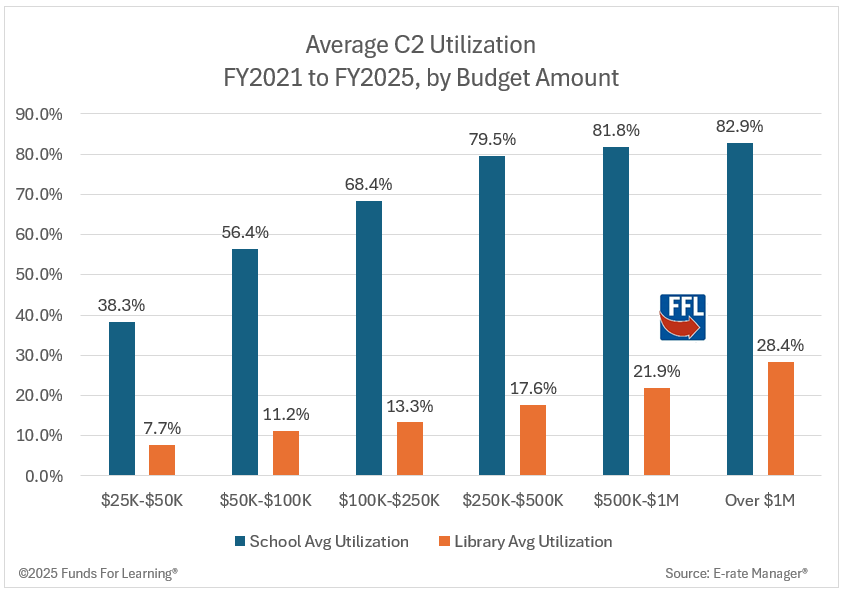A Missed Opportunity
Imagine discovering that two-thirds of eligible families never use their available food assistance benefits. That is the reality facing libraries when it comes to E-rate Category 2 (C2) support. Based on data from FY2021 through FY2025, 67 percent of libraries did not utilize any of their available discounts for Wi-Fi infrastructure. There were no applications, no equipment requests, and no activity.
This is not a case of mismanagement or misuse. E-rate funding functions more like a coupon. If an eligible school or library does not apply, no funds are distributed. But the underlying issue remains: many libraries are not accessing a program designed to support digital equity.
Why Libraries Participate Less Than Schools
While schools have made considerable progress, averaging over 60 percent Category 2 utilization, many libraries remain on the sidelines. Several recurring challenges explain this gap.
- Limited Staff Capacity
Unlike school districts that often have dedicated E-rate coordinators or administrative teams, many libraries, especially smaller or independent ones, operate with minimal staff. Our data shows that 73 percent of independent libraries had no C2 participation during the current budget cycle.
- Smaller Budget Sizes
Independent libraries receive smaller allocations compared to school districts, with an average of $60,080 versus $280,358. For smaller institutions, the time and administrative burden required to apply for E-rate support may outweigh the perceived benefits.
This trend becomes even more evident when analyzing utilization by budget amount.
As shown in the chart below, school participation increases significantly with budget size. Libraries follow a similar upward trend, but their overall utilization remains well below schools at every level.

- Longstanding Concerns About Compliance
Some libraries have expressed reservations about E-rate’s Children’s Internet Protection Act (CIPA) requirements. These mandates include implementing internet safety policies and content filtering. For libraries that emphasize open access to information, these requirements have raised concerns.
A Broader Pattern of Under-Participation
Libraries are not alone. A review of more than 32,000 applicants from FY2021 to FY2025 reveals a similar pattern across many institutions.
- Thirty-five percent of all eligible entities did not utilize their available Category 2 discounts
- Thousands of schools and libraries never submitted a C2 application
- These unclaimed discounts are not lost funds, but rather missed opportunities
Size and Structure Influence Participation
Participation rates improve significantly when applicants have scale and administrative support.
- Small schools with fewer than 300 students had a 39.7 percent average utilization
- Large schools with more than 1,000 students averaged 80.2 percent
- Independent entities averaged 33.1 percent
- District-managed entities averaged 73.1 percent
Organizations with centralized support for finance, IT, or compliance are better positioned to complete the E-rate process.
Why This Matters
E-rate is one of the few federal programs that provides recurring and predictable support for digital infrastructure. When it goes unused, communities miss out.
For Students
Every unclaimed E-rate discount could have improved Wi-Fi access in classrooms, especially in small or rural schools where infrastructure gaps are often greatest.
For Library Patrons
In many towns, the public library serves as the primary internet access point. When libraries do not participate in E-rate, they may continue to rely on aging infrastructure and provide a lower-quality experience for the community.
For Local Budgets
Category 2 discounts can cover between 20 and 85 percent of eligible costs. When these discounts are not used, the full cost of upgrades must be covered locally, if upgrades happen at all.
What Successful Applicants Are Doing Differently
Among the one-third of libraries that have used their Category 2 support, a few patterns stand out.
Consistent Engagement
Libraries that regularly participate tend to plan for E-rate annually. They stay current on eligibility rules, discount calculations, and filing deadlines.
Shared Administrative Support
Libraries that are part of a city, county, or regional system often benefit from shared administrative resources. This makes it easier to participate without creating a heavy local burden.
Independent E-rate Guidance
Some libraries improve outcomes by working with experienced E-rate consultants or participating in state consortia that offer compliance assistance. These support models respect program rules and help guide applicants through the competitive bidding process.
Recommendations for Libraries and Schools
With a new five-year Category 2 cycle beginning in FY2026, this is a timely opportunity for eligible applicants to reassess their participation.
For Libraries
- Determine if your library was eligible but inactive during the current cycle
- Review CIPA compliance policies with your leadership or legal team
- Explore regional consortia or statewide initiatives for administrative support
- Designate a staff member to track E-rate updates and deadlines
For Schools
- Review utilization data from the current cycle
- Plan for infrastructure improvements that benefit all student populations
- Maintain internal processes that support consistent applications each year
A Smart Time to Re-Engage
E-rate is a powerful tool for improving educational and community internet access. And for organizations that have not yet taken full advantage, the FY2026 through FY2030 cycle offers a fresh start. The Funds For Learning’s Category 2 Budget Calculator for FY2026–2030 can help your team understand how much support you may qualify for under the new cycle.
There is no penalty for missing out in the past. The next opportunity is just ahead.

